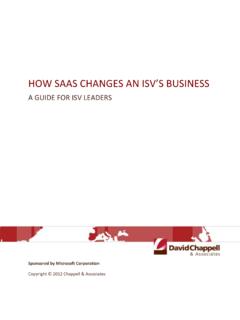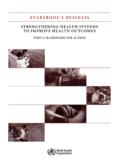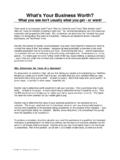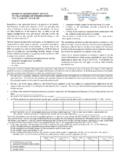Transcription of Managing a U.S. Business School Professor Shortage
1 Research in Higher Education Journal Volume 2. Managing a Business School Professor Shortage Robert S. Owen Texas A&M University-Texarkana Abstract The Business School accreditation agency, AACSB, has been predicting a future Shortage of professors in Business schools. Factors that have been advanced in support of a looming Shortage include increased future student enrollments, mass retirements of aged professors , decreased production of fresh doctoral graduates, and the taking of faculty employment outside of academe or the Actual data, however, show that the student-age population is not going to change substantially for the foreseeable future, that boomer-aged employees are not likely to retire anytime soon, that a decline in the supply of new Business doctor graduates is referenced from an oversupply that existed throughout the 1990s, and that loss to foreign employment is less than it was in the 1990s.
2 If a Shortage is indeed looming, the experienced lost generation of underemployed surpluses from the 1990s could be used to fill gaps in fresh doctoral supply. Keywords: Professor Shortage , Business School Professor , Business doctor, AACSB. accreditation, enrollment forecast Managing a Business , Page 1. Research in Higher Education Journal Volume 2. Introduction This assessment addresses various factors that many have put forth in predicting future Business faculty shortages. Predicting a supply and demand Shortage of Business doctors, if without substantive supporting evidence, is socially irresponsible because of the cyclic chaos that this can and has caused in the academic marketplace: wildly high salary requests by job candidates, an inability of Business schools to advance on the assumption of shortages and a market of candidates who are unwilling to accept reasonable salaries, followed by an oversupply of new doctors that results from the promise of future high-demand, high salary job market.
3 AACSB ( Business School accrediting agency) predictions of shortages fifty years ago resulted in an oversupply of new doctorates in the 1970s. AACSB predictions of shortages in the 1980s resulted in an oversupply of new doctorates in the 1990s. The surplus doctorates of the nineties were either forced to take faculty positions at bottom-end schools that constrained their scholarly growth opportunities or to take positions outside of academe that destroyed all aspirations of an academic career. At graduation, the typical new Business doctor is age 35, is married, and has taken a five year break out of the workforce to complete the degree (Survey of Earned Doctorates, 2007) the lives of entire families are destroyed during an oversupply.
4 Cycle job market. In the hopes of diminishing yet another oversupply cycle, the present analysis examines factors that impact the demand (need) for doctorally-qualified Business faculty. A. repeat of past oversupply cycles might be avoided if realistic projections can be maintained. If there is indeed a pending Shortage of Business doctors, the lost generation of under-employed but experienced, doctorally-qualified surpluses of the nineties could be considered as more viable alternatives to the current calls for hiring untrained, academically unqualified Business practitioners and inexperienced new doctors from non- Business disciplines. Historical Timeline In 1958, AACSB warned that there would be a Shortage of 2800 Business School professors by 1970 (Gordon and Anderson, 1958).
5 However, a 1972 survey of marketing departments was conducted to answer the question of whether there was an oversupply of new marketing doctors. The findings suggested that during 1973 and 1974, 279 new doctorates would be competing for only 172 positions that required a doctor degree (Shawver, 1973). A. 1974 survey of accounting departments also indicated that the demand for doctorates, as estimated by the responding schools, would be decreasing in the next several years (Lossett and Moustafa, 1975). Fifty years later, AACSB is still warning of a Shortage of 2400 Business School professors by 2012 (AACSB, 2007). (In fifty years, the supposed Shortage has decreased by 400!) Quoting AACSB sources, a Business Week article (Damast, 2007) claims that Business schools are at a tipping point for future gloom, with such dire predictions that some schools will be in danger of losing AACSB accreditation due to the Professor Shortage .
6 In the past five years, the overall production of Business PhDs declined .. an entire population of Business - School professors are [sic] expected to retire in the next few years, leaving a vacuum in the B- School classroom .. the B- School world is looking to the larger academic world for help, hoping to convince a psychology Professor , for example, to take a job as a marketing Professor .. Managing a Business , Page 2. Research in Higher Education Journal Volume 2. Yet according to Survey of Earned Doctorates (2007), conducted since 1957 and funded by several government agencies, the overall production of Business doctors actually increased from 1065 in 2000 to 1168 in 2005 (see Table 1; note that the 2007 compilation is on data collected from 2005 graduates).
7 A problematic issue with the suggestion of tapping the pool of new psychology doctors is that their production decreased from 3616 in 2000 to 3327 in 2005. (see Table 1). Table 1: Doctor Production in Selected Fields 1975 1980 1985 1990 1995 2000 2005. count pct. count pct. count pct. count pct. count pct. count pct. count pct. all fields 32952 31019 31295 36065 41747 41361 43554 engineering 3002 2479 3166 4894 6008 5323 6404 psychology 2751 3098 3117 3281 3429 3616 3327 education 7360 7586 6733 6509 6648 6432 6229 Business 787 640 789 1036 1330 1065 1168 Source: Survey of Earned Doctorates (2005). AACSBs prediction of mass retirements is suspect from several perspectives. The Survey of Earned Doctorates shows that there were substantially fewer Business doctors produced in the 1960s and 1970s.
8 Additionally, some of those were lost to early retirement incentives in the belt- tightening 1980s, minimizing the effects of the predicted mass retirements by that generation. Furthermore, surveys by AARP (2003, 2004) found that members of the baby boomer generation, who would have obtained Business doctor degrees around the mid 1990s (median age 35 according to the Survey of Earned Doctorates; see Table 2), don't plan on retiring anytime soon. On the basis of US Census data, it appears that the college age population should stay roughly flat (on average) for the next two decades. The remainder of this assessment will expand on these sorts of issues. First, factors related to the Business doctor surpluses of the 1990s will be addressed.
9 This is followed by an assessment of Business doctor demographics: trends in Business doctor production, losses of Business doctors to non-academic jobs and foreign placement, and issues related to the likelihood that there will be a mass exodus of ageing professors through retirement. Finally, trends in the population and the potential for future student enrollments is discussed. Oversupply of New Business Doctors Through the 1990s When AACSB publicizes a decrease in doctoral graduates, it is using a period of peak oversupply as the standard. The late 1980s saw an increase in doctoral student enrollments, feeding an increase to record high outputs of new doctorates in the 1990s.
10 In the early 1980s, AACSB was cited for saying that it would take 11 years to fill Business faculty vacancies (Fiske, 1981). In the middle 1980s, AACSB was reporting a faculty Shortage of twenty percent, expecting it to continue into the 1990s despite an anticipated drop in student enrollments (Whalen, 1984); this Shortage was attributed to Business faculty salary gains of percent in 1984 (Whalen) and percent in 1985 (Cebrzynski, 1985). By the late 1980s, AACSB was being cited for saying that faculty vacancy rates were twenty-five percent in Business disciplines (Pal and Waldauer, 1988). AACSB publicity in the 1980s about a looming Shortage of Business doctors and resultant high salaries was likely a factor in the decision of some to pursue a doctoral program.

















